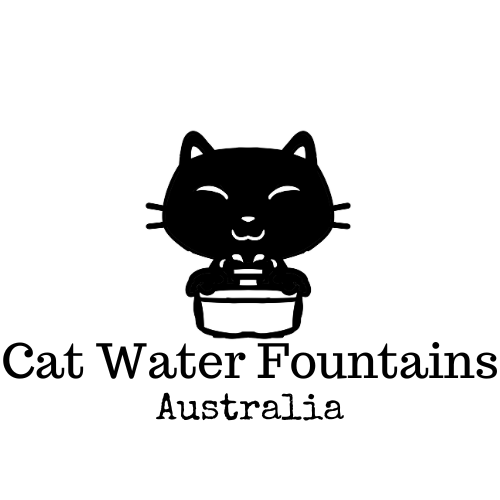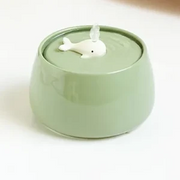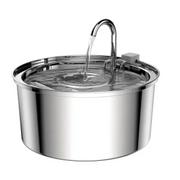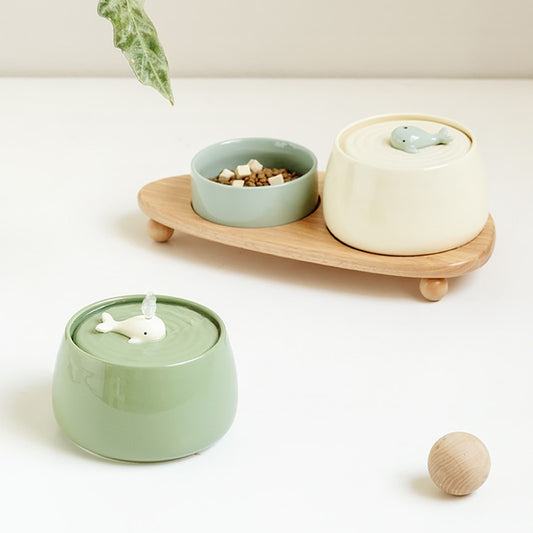Can Cats Cry? Understanding Cat Emotions
Cat Water Fountains Australia
Share This Article
As a proud cat owner, you've likely marveled at the unique ways your feline friend expresses itself. But here's a question that might have crossed your mind: Can cats cry? Not just the typical meowing and yowling, but actual tears.
Can Cats Actually Shed Tears?
Contrary to popular belief, cats do have tear ducts, much like humans. These ducts produce tears that lubricate their eyes, so technically, cats can shed tears. However, it's crucial to understand that this physiological process differs significantly from the emotional crying we associate with humans.
Why Don't Cats Cry Like Humans?
Cats are capable of a wide range of emotions, from joy to frustration. However, they express these feelings through vocalisations, body language, and behaviours rather than tears. So, if your kitty is unhappy or distressed, you're more likely to see it hissing, puffing up its fur, or hiding rather than shedding tears.
- Emotional Tears
- Physical Tears
While it might be disappointing that our feline friends can't share in our tearful moments, it's fascinating to learn about the unique ways they express their emotions. The next time you notice your cat's eyes watering, it's probably not because they're moved by the latest episode of their favourite bird-watching show. Instead, it could be a sign of an eye infection, allergies, or another health issue.
Understanding Cat Tear Ducts: The Anatomy
Ever wondered why your cat doesn't shed tears like humans? The answer lies in the anatomy of their eyes. Let's take a closer look.
Unlike humans, a cat's tear ducts are not designed to overflow with tears when they are feeling emotional. Instead, their ducts work to keep their eyes lubricated and healthy. When a cat blinks, a tear film covers its eye, removing dust or debris and keeping the eye clean and moist. This tear film consists of three layers:
- Mucous Layer - Helps the tear film stick to the eye.
- Aqueous Layer - Hydrates the eye and provides nutrients.
- Lipid Layer - Prevents the tear film from evaporating too quickly.
When functioning correctly, excess tears drain through the nasolacrimal duct, a small tube leading to the back of the throat.
No Crying Over Spilled Milk. So, Can Cats Cry?
Unlike humans, cats don't have emotional tears. Their tear ducts maintain eye health rather than expressing sadness or joy. Imagine watching a film with an emotional scene: while you might shed a few tears, your cat will remain unfazed, lacking the biological mechanism for emotional tears.
When Tears Could Signal a Problem
Considering the purpose of a cat's tear ducts, if you notice your cat's eyes are excessively watery, it could indicate irritation or an issue with their tear ducts. In such cases, consulting with a vet is advisable.
Misconceptions about Cats Crying: Separating Fact from Fiction
Let's debunk some common misconceptions about cats and their crying.
Real Tears or Just an Illusion?
Fact: Cats produce tears, but not for the reasons we might think. Unlike humans, a cat's tears don't signify emotional distress. Instead, they're part of the body's natural mechanism to keep the eyes moist and free from dust and debris. When you see your cat's eyes welling up, it's typically a sign of eye irritation or health issues.
Do Cats Express Sadness?
Fact: Even though cats can't cry emotional tears, they do experience a range of emotions such as happiness, sadness, and fear. However, they communicate these feelings differently. Instead of shedding tears, a sad cat might show signs like loss of appetite, excessive grooming, or decreased activity.
Do Cats Cry for Attention?
Fact: Cats can be clever attention-seekers. A cat might meow persistently, nudge you with their paw, or seem to be crying if they want your attention. But remember, they're not producing tears to tug at your heartstrings. They're using the tools they have to communicate their needs.
Do Cats Cry out of Pain?
Fact: A cat in pain or discomfort won't cry tears but will show other signs. They might hide, become unusually aggressive, or exhibit a dramatic change in behaviour. If your cat is acting out of character, a trip to the vet might be necessary.
Emotional Responses in Cats: What Signs to Look For
If you're a cat parent, you've likely spent time trying to decipher your furry friend's emotions. Unlike dogs, who wear their hearts on their sleeves, cats can be more cryptic. But worry not! Cats indeed exhibit a range of emotions, and once you know what to look for, you'll better understand their feelings.
1. Body Language and Vocalisations
Look at your cat's tail. A high, straight tail often signifies happiness, while a puffed-up, bristled tail indicates fear or aggression. If your cat is thumping its tail, it could be irritated.
Observe your cat's eyes. Narrowed eyes or dilated pupils can indicate fear or aggression, whereas slow blinking often means your cat is relaxed and trusts you.
Listen to your cat. Cats use various vocalisations to express their emotions. A loud, drawn-out meow can be a plea for attention, while a hiss or growl is a clear warning sign of upset or fear.
2. Behavioral Changes
Changes in your cat's behaviour can also indicate its emotional state.
Eating habits. A sudden change in appetite, whether eating less or more, can be a sign of stress or illness.
Litter box usage. Behavioural issues such as urinating outside the litter box can indicate stress.
Excessive grooming. While cats are known for their cleanliness, over-grooming can be a sign of anxiety or other health issues.
Remember, each cat is unique and may show different signs depending on its personality and past experiences. Observing your cat's typical behaviour makes it easier to spot changes.
3. Environmental Factors
Cats are sensitive to their surroundings. Changes in the environment, such as moving to a new home, a new person or pet in the house, or even rearranging furniture, can cause stress in cats. Signs of a stressed cat include hiding, aggression, or becoming unusually clingy.
4. Eye Infections and Allergies
Cats can develop various eye problems, including infections and allergies. Dr Jane Smith, a renowned veterinarian, explains, "Cats can develop conjunctivitis, similar to pink eye in humans, which can lead to excessive tearing. Dust particles, pollen, or certain foods can trigger allergic reactions, causing watery eyes."
If your feline friend has a discharge that's clear and watery, it may be allergy-related. But if the discharge is coloured or accompanied by redness and swelling, consult a vet, as these could indicate an infection.
5. Blocked Tear Ducts
Another common cause of tear overflow in cats is blocked tear ducts. Tears usually drain through small openings in the corners of the eyelids. But when these ducts get obstructed due to infection, inflammation, or physical deformity, the tears overflow.
Dr Smith advises, "Regularly check your cat's eyes for any unusual redness or swelling. If your cat squints or blinks excessively, it might be experiencing discomfort due to a blocked tear duct."
6. Corneal Problems
Cats' eyes are delicate and can easily get scratched or injured, leading to corneal problems. A tiny scratch on their cornea can cause their eyes to water. Severe conditions like corneal ulcers or injuries can also lead to increased tear production.
Renowned animal behaviourist John Doe highlights, "Your cat might blink excessively, avoid light, or keep its eye closed if it's dealing with a corneal issue. These signs warrant a trip to the vet to avoid further complications."
How to Respond and Comfort to a Crying Cat
If you notice your cat's eyes watering, don't panic. Here are some steps you can take:
- Keep the cat's face clean by gently wiping the tear stains with a soft, wet cloth.
- Shield your cat from potential allergens. Keep your home clean and dust-free, and be mindful of new foods or products that could cause an allergic reaction.
- Consult a vet if the symptoms persist. They might prescribe eye drops or other treatments based on the cause of the excessive tearing.
Understanding that a cat's tears are often more about health than heartbreak can ensure your beloved pet's well-being. So, the next time you see those tiny droplets, remember – it's time for care and medical attention, not a box of tissues!









